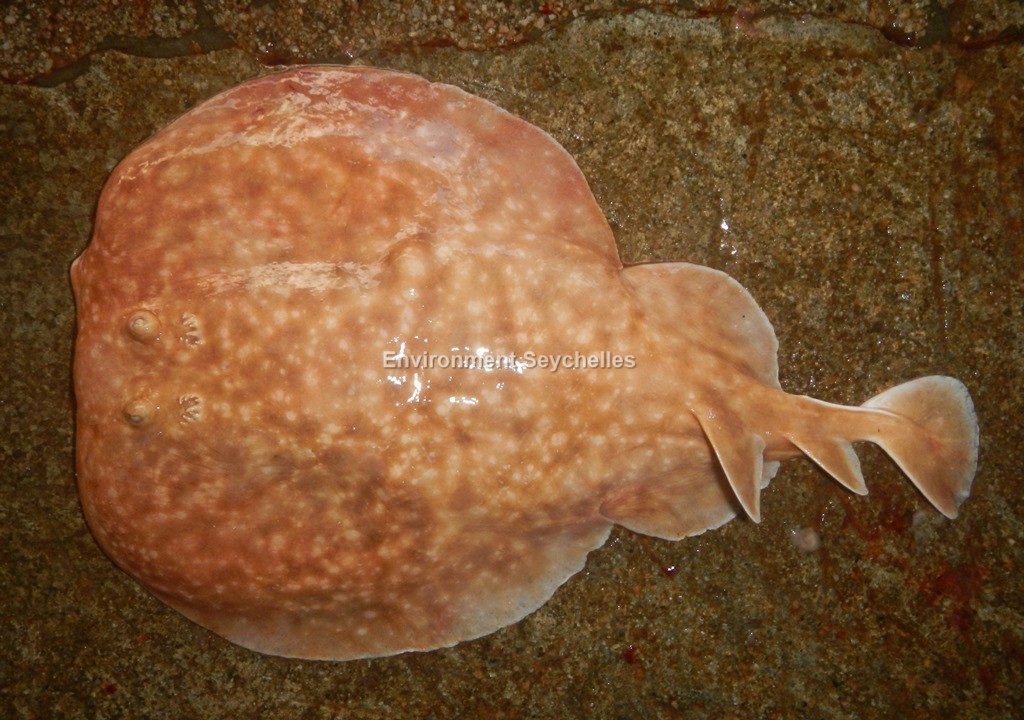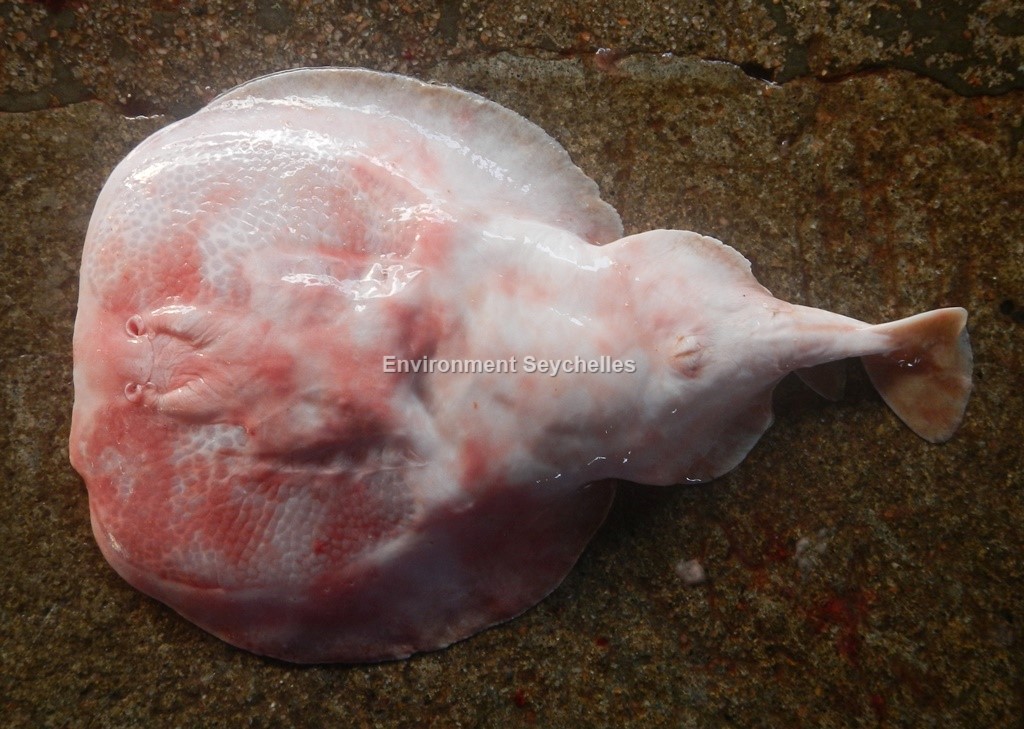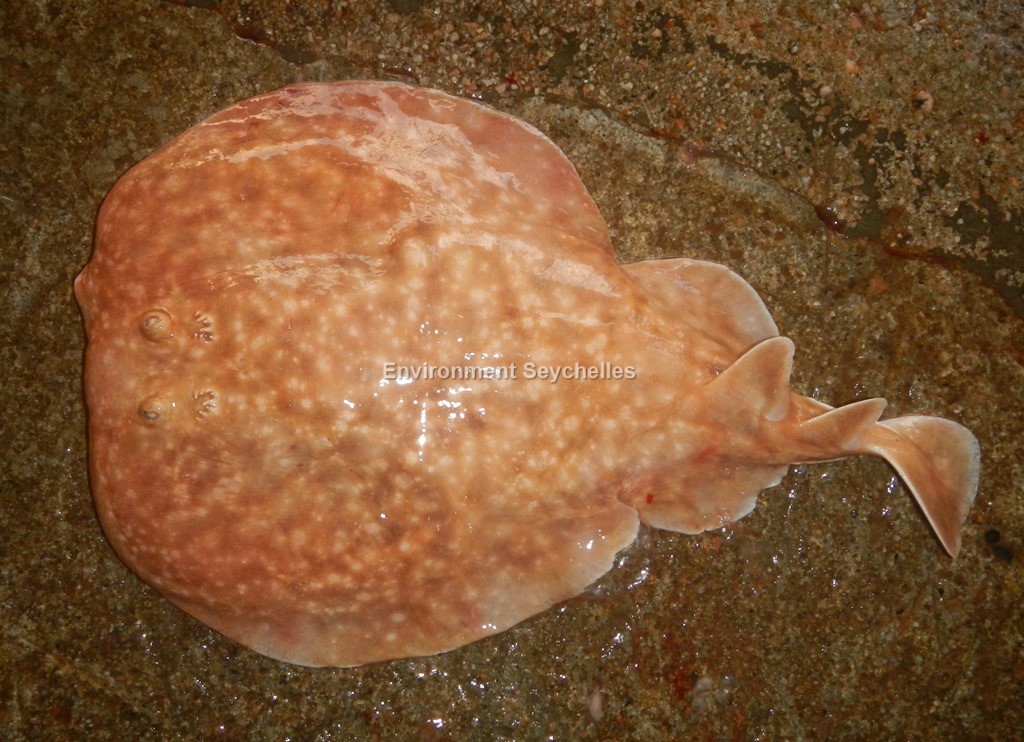Description:
Medium-sized torpedo ray, with a highly variable but distinctive marbled colour pattern. Disc fleshy, thick and circular; about as broad as long. Disc is widest slightly anterior to midpoint. Anterior margin straight with a slight median protuberance. Snout very short. Eyes small and slightly bulging. Eyes and spiracles proximate, eyes closer to spiracles than snout. Orbit smaller than interspiracular space and slightly larger than spiracle. Spiracles rounded, with up to 7 short papillae; posterior papilla longest. Nostrils with well-defined nasal flaps. Mouth arched, teeth in up to 50 rows. Electric organs more clearly visible in ventral than dorsal view. Pelvic fins broad, rounded posteriorly. Dorsal fins rounded to oval at apex first dorsal broad slightly taller than second. First dorsal situated entirely over pelvic fins. Tail very short with moderately developed lateral skinfold. Caudal fin upper lobe larger than lower. Apices of both lobes rounded to oval. Posterior margin of caudal fin straight to slightly rounded.
Colour. Highly variable, greyish, yellowish or reddish brown above, usually with numerous spots and blotches each smaller than interorbital space in size; sometimes with lighter outer rings forming ocelli. Blotches may form a regular reticulated pattern; margins of dorsal and caudal fins sometimes lightly coloured. Ventral surface creamy white.
Size:
Maturity: Lm unknown. Range unknown Max Length: 64cm TL.
Habitat and Ecology:
Benthic. Reef associated. Inhabits estuaries, intertidal zone and continental/insular coastal plains (depth 0-440m, commonly 3-50m). Often associated with sandy areas near deep rocky reefs. Feeds on a variety of fishes and cuttlefish. Prey stunned by its powerful electric discharge. Ovoviviparous.
Fishery Status:
This species is not protected or subject to fishery regulations. It is very rarely caught in the artisanal fishery. This specimen was caught in a fish trap. Elsewhere recorded as being caught accidentally by anglers.
Notes:
Distinct from other torpedo rays of the Western Indian Ocean in colour pattern. Colouration, however, is highly variable between populations and regional forms may form part of a species complex.
References:
Froese, R. & D. Pauly. Eds. 2019. FishBase. https://www.fishbase.se/summary/Torpedo-fuscomaculata (13/08/19).
Last, P.R. et al (2016). Rays of the World. CSIRO Publishing ISBN 9781501705328
Pheeha, S. 2004. Torpedo fuscomaculata. The IUCN Red List 2004: e.T44621A10927816. http://dx.doi.org/10.2305/IUCN.UK.2004.RLTS.T44621A10927816.en. (13/08/19).
Smith, M & Heemstra, P Eds. (1999). Smiths’ Sea Fishes Edition 6. Springer-Verlag Berlin Heidelberg 10.1007/978-3-642-82858-4
Citation:




Thank you for your blog post.Really thank you! Much obliged.
エロ下着diligence,and accuracy,
ラブドール リアルque hallará tan altos casamientos y prosperos? Reconozcome indigno._–Y vos no os casareis con ella? _–Para qué es hablar en esso? no naci yo para tanto bien.
broke your heart.ラブドール エロIn a long-term relationship,
Wow, great article post.Much thanks again. Great.
Thank you ever so for you blog.Really thank you! Fantastic.
I really enjoy the article. Will read on…
I truly appreciate this article. Really Great.
I value the article. Awesome.
I am so grateful for your blog.Really looking forward to read more. Fantastic.
Awesome blog.Really thank you! Awesome.
Wow, great post.Really thank you! Really Cool.
I think this is a real great blog article.Much thanks again.